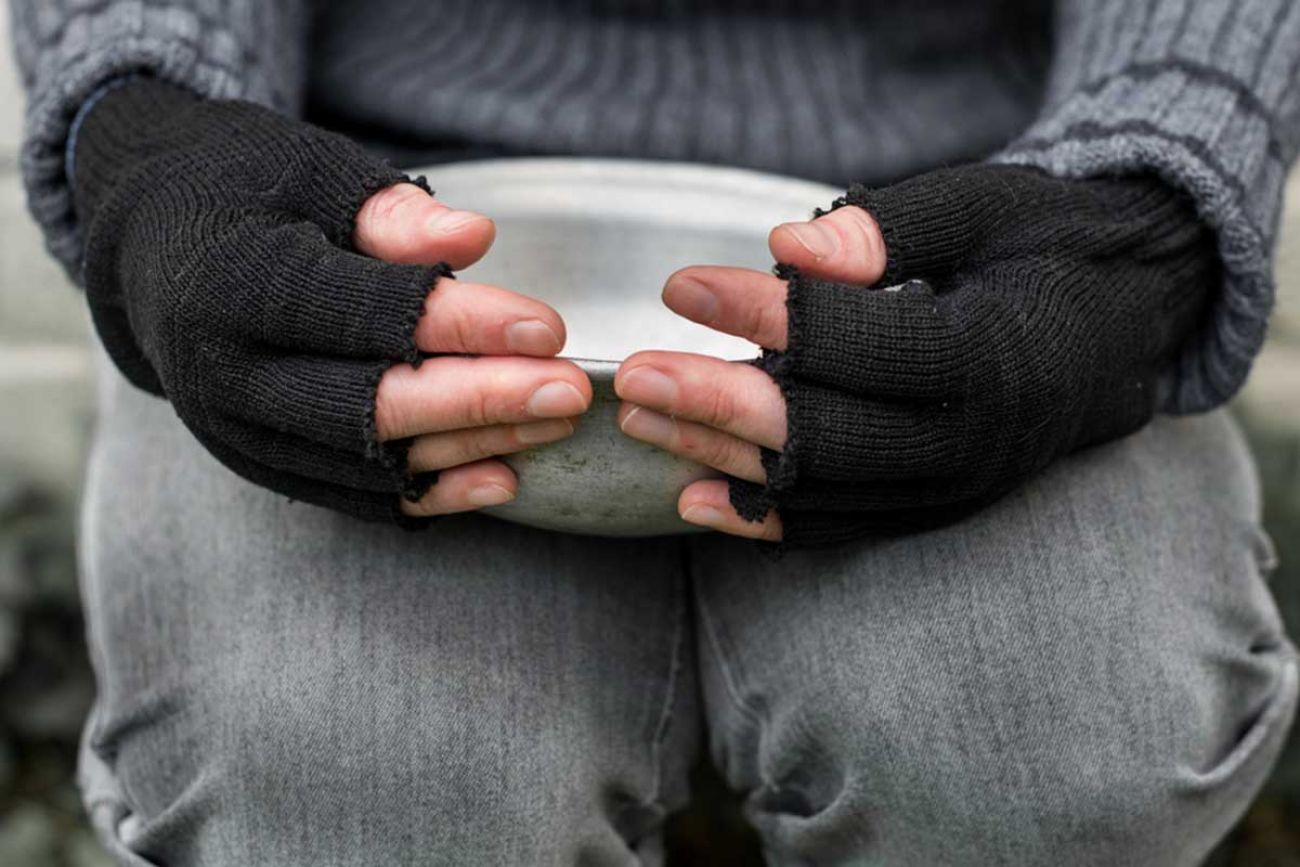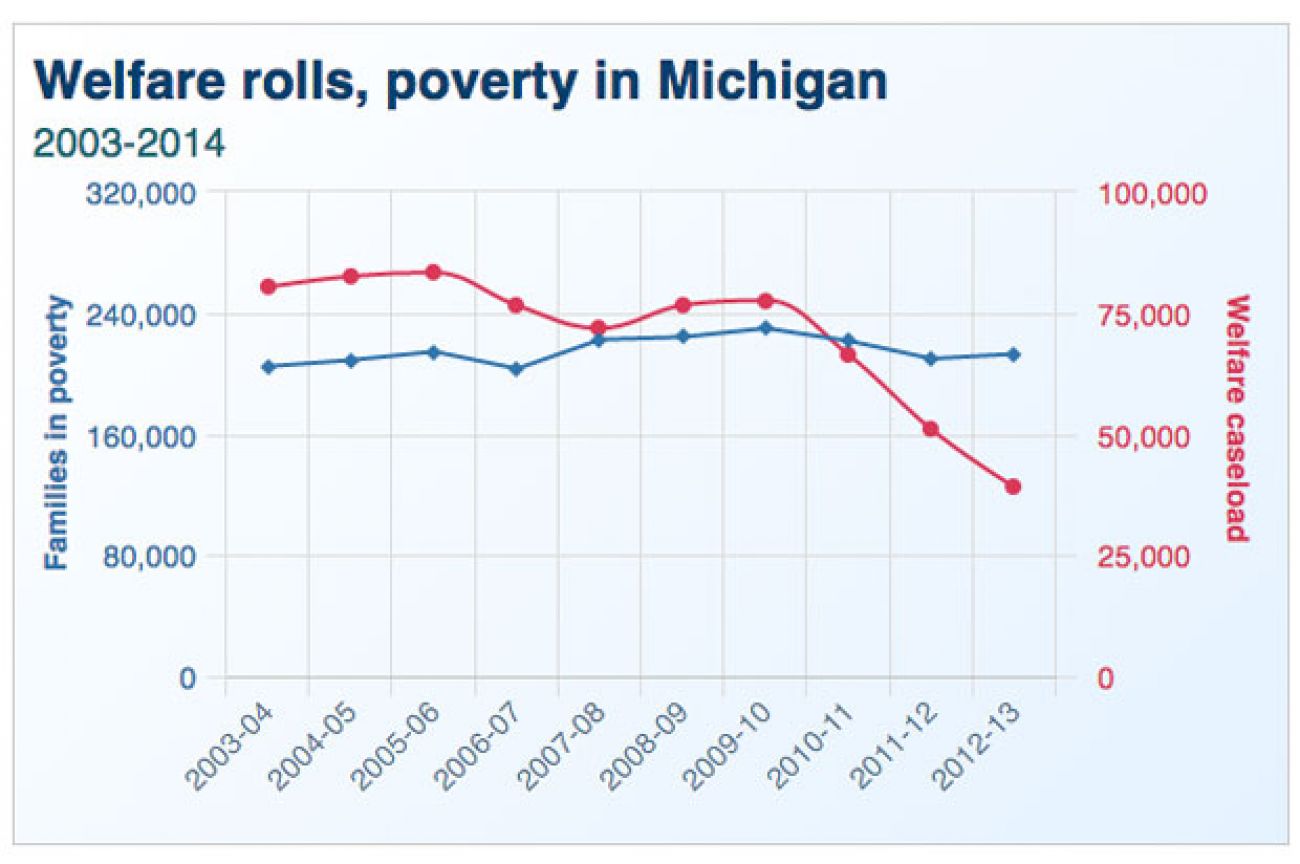$1B of Michigan’s welfare money went to college students who weren't poor

For more than a quarter century, policy makers have tinkered with Michigan’s social safety net. Whether reforms have improved the state’s welfare system remains a matter of ongoing debate.
Safety net and welfare reform issues are frequently in the spotlight – and likely to remain there in 2018 – for two reasons. Michigan has a large low-income population. And the social safety net costs taxpayers billions of dollars per year.
Sixteen percent of Michigan households and 22 percent of Michigan children currently live in poverty. Another 25 percent of Michigan households live above the poverty line, and have jobs, but live paycheck to paycheck with no savings, according to the Michigan Association of United Ways.
Related: How more affluent families get welfare for pricey private colleges
Meantime, health care and other social safety net programs total more than $25 billion dollars in the state budget. That’s 45 percent of the overall state budget, including pass-through federal revenues.
Reform Debates Through the Years
In 1991, Gov. John Engler signed a law ending general assistance, cutting off welfare payments of about $144 a month to 80,000 able-bodied adults without children. Critics said it would harm vulnerable recipients, while officials said the state could no longer could afford the program.
Fewer Families on Cash Assistance
Average monthly caseloads on state cash assistance by fiscal year.
2007: 85,389
2008: 72,568
2009: 70,540
2010: 79,233
2011: 79,660
2012: 58,641
2013: 49,165
2014: 38,387
Then, in 1996, Congress approved sweeping reform that converted federal welfare aid to states to block grants – giving them wide discretion on how to spend the funds. Backers said this would allow states to more nimbly help recipients off welfare and into work.
Welfare for Middle Class College Students
On average, half of all U.S. welfare money controlled by states goes to programs aimed at getting recipients back to work. They include cash assistance, child-care and work-related initiatives. In Michigan, it’s less than 25 percent - one of the lowest rates in the country.
Under federal welfare reform, state welfare spending must meet one of four goals: Helping needy families, getting recipients into jobs, reducing out-of-wedlock pregnancies and encouraging two-parent families.
Related health and welfare coverage from our 2018 Michigan Issue Guide
- Michigan's adverse health trends track along racal, poverty lines
- Health care in rural Michigan communities suffering, despite Obamacare
Since 2007, Michigan has spent more than a billion dollars from the welfare program on college scholarships, with some funds going to middle- and upper-income students attending private Michigan colleges. That includes students from families earning more than $100,000 a year.
Advocates for the poor argue those funds could be better used to help the truly needy. State officials maintain that students who attend college are less likely to have children out of wedlock.

New Limits on Cash Assistance
On paper, welfare spending in Michigan has remained level. But the number of Michigan families getting cash assistance fell by half from 2007 to 2013, even as tens of thousands of families still struggled with poverty and unemployment coming out of the Great Recession.
Concerned that some on welfare were abusing the system, state lawmakers in 2011 approved a measure to limit recipients to four years of cash assistance. Those who were on welfare for more than four years dating back to 2007 were kicked off the program.
Twelve months later, the state was spending $18 million less a month on cash assistance, likely the result of both welfare reform and an improving economy. While reform advocates said stiffer time limits would force recipients to find work, it is unclear how many found jobs since the state does not track recipients after they leave the system.
Drug Tests Come Up Negative
In 2013, legislators responded to allegations recipients were abusing cash benefits when they banned use of Bridge Cards at ATMs in casinos and strip clubs. Low-income residents can use cards to buy food and other items at the store. The measure was approved following revelations welfare recipients used benefits to get nearly $90,000 from a Detroit casino.
The following year Gov. Rick Snyder signed a law to create a one-year pilot program to screen some welfare recipients and test those suspected of drug use. In a 2016 report to legislators, the Michigan Department of Health and Human Services said the pilot program did not catch any recipients using illegal drugs.
Massive Computer Error
Michigan’s unemployment insurance fund is another piece of the safety net, giving workers a financial cushion when they lose jobs.
But a state calculation that it could streamline claims processing by turning fraud determinations over to a computer backfired, resulting in thousands of false findings of fraud.
In August, the state agreed to refund nearly $21 million to residents after reviewing cases in which the Unemployment Insurance Agency falsely accused tens of thousands of people of benefit fraud. The state found that more than 44,000 cases out of 62,784 with fraud findings did not involve fraud.
The UIA said it is committed to improve its system through enhanced training, policy changes and changes to the computer system.
KEEP DIGGING: MORE INFORMATION ON MICHIGAN’S SAFETY NET
- United Ways of Michigan: The ALICE Project
- Michigan League for Public Policy: “Failure to Invest in High Quality Child Care Hurts Children and State Economy”
- Citizens Research Council and Public Sector Consultants: “Policy Options to Support Children from Birth to Age Three”
- Bridge Magazine: “Fewer homeless veterans. More homeless children in state.”
- Bridge Magazine: “Broken – the Human Toll of Michigan’s Unemployment Frau
Explore the Facts & Issues Guide:
At A Glance
Slideshows…
Education & Talent
- K-12 Student Performance: Michigan's K-12 performance dropping at alarming rate
- School Reform: Many Michigan K-12 reform ideas are jumbled, broad, or wildly expensive
- Early Childhood: Michigan preschool funding has improved, but child care still unaffordable
- Higher Ed: College funding cuts in Michigan have led to fewer students, greater debt
Economy & Prosperity
- Economy: Michigan business climate improves, but educated workforce is shrinking
- Jobs & Labor: Demand for Michigan workers is very high, but many have given up looking
- Incomes: Michigan income growth hindered by lack of college graduates
- Business: Business incentives cost Michigan millions, and it’s uncertain they work
Quality of Life
- Public Health: Michigan's adverse health trends track along racal, poverty lines
- Health Care: Health care in rural Michigan communities suffering, despite Obamacare
- Safety Net: $1B of Michigan’s welfare money goes to college students who aren’t poor
- Water Issues: Michigan's Great Lakes are good, but water concerns include lead and Line 5
- Lands & Energy: Michigan battling 22 invasive forest species, high electric bills
- Michigan Tourism: Does state make $8.33 for every $1 spent on Pure Michigan campaign?
- Infrastructure: Michigan needs $4B more per year for infrastructure, but how to pay for it?
- Cities: In Michigan, more than 150 communities are financially distressed
- Rural Michigan: Limited Internet in rural Michigan depresses student, business opportunity
- Public Safety: Michigan pays 18% less per citizen than nat'l average for public safety
Government & Reform
- Michigan Taxes: Michigan gives more tax breaks than it collects for schools, government
- State Spending: Big government? Michigan's state, local workforce 2nd smallest in nation
- Ballot Issues: 2018 Michigan ballot initiatives may decide marijuana, gerrymandering
- Gov't Reform: Despite low trust of gov't, Michigan legislators have done little to change
Who We Are & The Facts on Our Facts
See what new members are saying about why they donated to Bridge Michigan:
- “In order for this information to be accurate and unbiased it must be underwritten by its readers, not by special interests.” - Larry S.
- “Not many other media sources report on the topics Bridge does.” - Susan B.
- “Your journalism is outstanding and rare these days.” - Mark S.
If you want to ensure the future of nonpartisan, nonprofit Michigan journalism, please become a member today. You, too, will be asked why you donated and maybe we'll feature your quote next time!

